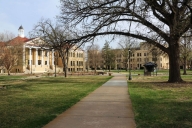You have /5 articles left.
Sign up for a free account or log in.
The idea that the country needs more graduates in science, technology, engineering, and math (STEM) fields is not new, but several universities are now increasing their focus on finding those potential graduates, turning specifically to community colleges.
The University of Maryland Baltimore County announced today that it will spend three years building and piloting a national model for increasing the number of community college students who ultimately earn bachelor’s degrees in STEM fields. The program is funded by a $2.6 million grant from the Bill & Melinda Gates Foundation. The City Colleges of Chicago and the University of Illinois at Chicago recently announced a partnership, along with a $100,000 grant from the Association of Public and Land-Grant Universities' Minority Male STEM Initiative, which is funded by the Kresge Foundation, to support male minority STEM students at the community college system in transferring to and graduating from Illinois-Chicago. Additionally, earlier this year, Mount Holyoke College received a $600,000 grant from the National Science Foundation to recruit and support female community college students in STEM fields.
Each program is different, but they all share a common purpose: giving community college students an accessible path to a four-year degree in a STEM field.
Transfer students in STEM fields face the same problems any community college transfer might face: courses that don’t line up, credits that don’t transfer, trouble adjusting to the class size or format, a lack of a community feeling. Those problems, however, are often more acute for STEM students. After all, 500-person lecture classes are more common in science departments, and requirements are often more stringent in those fields, too; an engineering student who takes the wrong class in his first year at community college will likely have a harder time finishing a bachelor of science degree in four years than an English student would have with a bachelor of arts.
“There are all sorts of differences,” said Bill LaCourse, dean of the College of Natural and Mathematical Sciences at UMBC. “And yes, we have students coming from high school, but there are all kinds of first-year programs. Transfer students … come in not knowing exactly what to do because we never gave them the grounding to understand what it takes or what it entails.”
Becky Wai-Ling Packard, a professor of psychology and education at Mount Holyoke, has studied these problems, particularly focusing on women. Packard recruited a cohort of 30 Massachusetts community college students in STEM fields and interviewed them during their last semester at their community colleges and after their first semester at a four-year institution. Of the 30 students, 26 transferred to four-year colleges, and 22 persisted in STEM majors after the first semester.
More revealing than the numbers, however, are the interviews. Most of the students reported positive feelings about their community college experiences, citing inspiring professors, peer support, and helpful advising as reasons for their success. Once the students got to their four-year colleges, however, sentiment turned negative. Most students reported struggling in at least one course, and said that compared to their community college courses, the four-year classes often moved at a faster pace, were more difficult, and provided less support. The content in the courses didn’t always line up, either. One student said she had taken the first semester of organic chemistry at her community college, but the second semester course at her four-year college assumed knowledge of things she hadn’t learned, so even though she had earned credit for the first semester of organic chemistry, she ended up having to take it over again.
“Successful transfer depends on alignment between the community colleges and the four-year college,” Packard wrote in an op-ed earlier this month. “Currently, that type of alignment is the exception rather than the rule. Too often, students who are promising future scientists leave their major because particular credits did not transfer, or because they do not feel invited into the science community at four-year institutions, not because they don’t have the talent.”
Mount Holyoke’s STEM transfer initiative, which Packard plays a role in leading, focuses on recruiting promising community college students, providing them with scholarships to ease the financial burden of studying at a private, four-year college, and mentoring them through to graduation. Students are brought to campus before classes start for advising and orientation specific to the program. They meet with science faculty members regularly, are given information about academic expectations, and are enrolled in a one-credit course in the fall designed to build excitement about studying science at Mount Holyoke.
“There is clearly a need to demonstrate to community college students, especially women, that studying science disciplines is a viable academic or career path,” Packard wrote in the op-ed.
LaCourse sees that need, too, and he believes it starts with collaboration among all the institutions involved.
The Gates Foundation grant is meant to promote that collaboration and to allow UMBC to develop a tool kit other universities can use to help STEM students at two-year colleges transfer and earn four-year degrees. Right now, UMBC is working with four Maryland community colleges -- Anne Arundel Community College, Community College of Baltimore County, Howard Community College, and Montgomery College -- to develop a pathway from a community college to a bachelor’s degree in a STEM field.
“Students come from many different colleges and two-year institutions and they go to many different four-year institutions, but nothing’s aligned,” LaCourse said.
Articulation agreements are not the answer either, LaCourse said. With a one-year planning grant, he has been working with chemistry faculty from UMBC and the four community colleges and found that aligning curriculums is much more complex. For example, although professors were using the same textbook, they taught different chapters in the first and second semesters. They also used different tests and different types of questions, had wildly different class sizes, and varied as to whether or not they used a lab component.
“Our students come from these four community colleges, but when was the last time we sat down as a chemistry group or a math group?” LaCourse said. “We’re expecting people to know what the other person is doing.”
LaCourse has been documenting the discussions and the process, hoping to provide a sort of template for others. In the meantime, he has gained a clearer idea of the barriers facing transfer students, and is working to ease them. Already, the chemistry departments at the four community colleges have agreed to create a common test question bank.
The goal, LaCourse said, is to build a system that includes the community colleges and the university. From the beginning of their careers, whether at one of the two-year colleges or at UMBC, LaCourse wants STEM students to know what they’re working toward and who is available to help them. Besides better aligning courses and expectations, LaCourse is also discussing ideas like an online portfolio for science students, providing students information about specific careers so they can decide earlier what field they want to pursue, and including diagnostics and personalized modules in the transfer process.
“If transfer students fail, it’s really our failure,” said LaCourse, himself a graduate of a two-year college. “It’s not their failure, it’s ours, because we haven’t been talking, we haven’t been aligning ourselves."
The City Colleges of Chicago and Illinois-Chicago partnership will provide a total of 50 minority male students who graduate from the colleges guaranteed transfer to the university, along with academic support, mentoring, and a paid research internship.








.jpg?itok=sZ1Pn-fP)